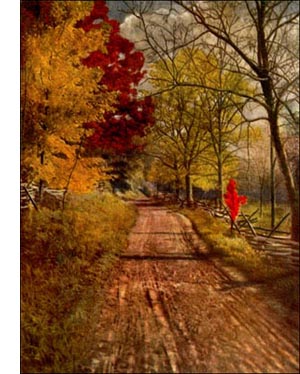Red or Norway Pine Tree
 Red or Norway Pine (P. resinosa, Ait.)-Large, broadly pyramidal tree, 7; to 120 feet high, branched to the ground, with stout twigs. Bark shallowly furrowed into flat, scaly ridges, reddish brown, rich in tannin; branches rough, glabrous. Wood pale red, light, hard, resinous; sap wood yellow or white. Buds conical, tapering, with loose, red scales. Leaves in clusters of twos, from close, persistent sheaths, z inch long; needlelike, dark green, 6 inches long. sharp pointed, flexible semicircular in cross section, toothed near tip, with rows of pale dots lengthwise. Flowers: staminate red, abundant, clustered at base of season's shoot: pistillate 1 to 3, terminal, peduncled, reddish, oval. Fruits ovate, 1 to 3 inches long, standing at right angles with stem; biennial; scales thickened, 4-angled at apex, unarmed; seeds winged. Preferred habitat, dry, sandy plains and rocky ridge-s. Distribution, southern Canada, Northern States from Maine to Minnesota; south to Pennsylvania. Uses: MoSt picturesque and desirable of pitch pines for ornamental planting in the North; grows rapidly from seed; free from insect and fungous injuries. Lumber used in heavy construction; for bridges, piles, docks, buildings, masts and spars.
Red or Norway Pine (P. resinosa, Ait.)-Large, broadly pyramidal tree, 7; to 120 feet high, branched to the ground, with stout twigs. Bark shallowly furrowed into flat, scaly ridges, reddish brown, rich in tannin; branches rough, glabrous. Wood pale red, light, hard, resinous; sap wood yellow or white. Buds conical, tapering, with loose, red scales. Leaves in clusters of twos, from close, persistent sheaths, z inch long; needlelike, dark green, 6 inches long. sharp pointed, flexible semicircular in cross section, toothed near tip, with rows of pale dots lengthwise. Flowers: staminate red, abundant, clustered at base of season's shoot: pistillate 1 to 3, terminal, peduncled, reddish, oval. Fruits ovate, 1 to 3 inches long, standing at right angles with stem; biennial; scales thickened, 4-angled at apex, unarmed; seeds winged. Preferred habitat, dry, sandy plains and rocky ridge-s. Distribution, southern Canada, Northern States from Maine to Minnesota; south to Pennsylvania. Uses: MoSt picturesque and desirable of pitch pines for ornamental planting in the North; grows rapidly from seed; free from insect and fungous injuries. Lumber used in heavy construction; for bridges, piles, docks, buildings, masts and spars.The red pine is the only American member of a group of OldWorld pines of which P. sylvestris, the Scotch pine of Europe, is a familiar example. The paired leaves and red bark are signs of kinship. Both are common in cultivation in America, and we shall distinguish the native tree by its longer leaf and the heavy tufting of its twigs; the short leaves of P. sylvestris are thinly and evenly scattered along its branches.
An early Spanish explorer erroneously described this tree as identical with the variety of the Scotch pine that grows in Norway. In this way it came by its second name.
There is a lustiness and symmetry of growth and an expression of hardiness and health in the red pine which makes the other pitch pines look ragged and discouraged, and the graceful white pines delicate and unequal to the struggle of life. No handsomer pine than this one is found in the Northeastern States.
The wood of red pine is not what we might expect from such a tree. Rich in resin and fine grained, yet its durability is not to be depended upon. Its height gave masts and spars of great size and free of blemishes. It was once shipped in quantities to England out of the Canadian woods to be used at the dockyards, and for piles and bridge timbers. Of late years better pine has been substituted. Turpentine and tar are not derived from this tree, despite its name, resinosa, "full of resin." Less pitchy than P. rigida, soft like P. Strobus, the wood seems intermediate between the two.
The living tree is more valuable than its log; when the lumberman scoffs at the red pine the landscape gardener takes it up. It grows on exposed and sterile coasts, where it rapidly forms effective windbreaks and beautiful groves. It adds a distinct type of beauty to parks and private grounds. Its hardiness and rapidity of growth commend it to the colder states. Not the least of its good points in the home grounds is that its two leaves in their close, deep sheaths furnish children exactly the right material for chains, the making of which is one of the most absorbing pleasures of childhood.